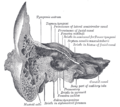Promontory of tympanic cavity
Promontory of Tympanic Cavity
The promontory of the tympanic cavity is a prominent anatomical feature located within the middle ear. It is a bony projection that separates the middle ear from the inner ear and plays a crucial role in the transmission of sound waves.
Anatomy
The promontory is formed by the basal turn of the cochlea, which is the spiral-shaped structure responsible for hearing. It is situated on the medial wall of the middle ear, adjacent to the oval window. The oval window is a membrane-covered opening that connects the middle ear to the inner ear.
The promontory is covered by a thin layer of mucous membrane, which is continuous with the lining of the middle ear. This mucous membrane contains numerous blood vessels and nerve endings, making the promontory highly sensitive.
Function
The main function of the promontory is to transmit sound vibrations from the middle ear to the inner ear. When sound waves enter the ear canal, they cause the eardrum to vibrate. These vibrations are then transmitted through the ossicles (the small bones of the middle ear) to the oval window.
As the oval window moves in response to the sound vibrations, it creates pressure waves within the fluid-filled cochlea. These pressure waves stimulate the hair cells within the cochlea, which convert the mechanical energy of the sound waves into electrical signals that can be interpreted by the brain as sound.
The promontory plays a crucial role in this process by acting as a bridge between the middle ear and the inner ear. Its location adjacent to the oval window allows for efficient transmission of sound vibrations, ensuring optimal hearing function.
Clinical Significance
The promontory of the tympanic cavity can be of clinical significance in certain medical conditions. For example, in cases of otosclerosis, a condition characterized by abnormal bone growth in the middle ear, the promontory may become fixed and immobile. This can lead to conductive hearing loss, as the transmission of sound vibrations is impaired.
Furthermore, the promontory can serve as a landmark during surgical procedures involving the middle ear. Surgeons may use the promontory as a reference point when performing procedures such as cochlear implantation or stapedectomy.
See Also
- Middle Ear
- Inner Ear
- Oval Window
- Cochlea
- Otosclerosis
- Conductive Hearing Loss
- Cochlear Implantation
- Stapedectomy
References
Transform your life with W8MD's budget GLP-1 injections from $125.
W8MD offers a medical weight loss program to lose weight in Philadelphia. Our physician-supervised medical weight loss provides:
- Most insurances accepted or discounted self-pay rates. We will obtain insurance prior authorizations if needed.
- Generic GLP1 weight loss injections from $125 for the starting dose.
- Also offer prescription weight loss medications including Phentermine, Qsymia, Diethylpropion, Contrave etc.
NYC weight loss doctor appointments
Start your NYC weight loss journey today at our NYC medical weight loss and Philadelphia medical weight loss clinics.
- Call 718-946-5500 to lose weight in NYC or for medical weight loss in Philadelphia 215-676-2334.
- Tags:NYC medical weight loss, Philadelphia lose weight Zepbound NYC, Budget GLP1 weight loss injections, Wegovy Philadelphia, Wegovy NYC, Philadelphia medical weight loss, Brookly weight loss and Wegovy NYC
|
WikiMD's Wellness Encyclopedia |
| Let Food Be Thy Medicine Medicine Thy Food - Hippocrates |
Medical Disclaimer: WikiMD is not a substitute for professional medical advice. The information on WikiMD is provided as an information resource only, may be incorrect, outdated or misleading, and is not to be used or relied on for any diagnostic or treatment purposes. Please consult your health care provider before making any healthcare decisions or for guidance about a specific medical condition. WikiMD expressly disclaims responsibility, and shall have no liability, for any damages, loss, injury, or liability whatsoever suffered as a result of your reliance on the information contained in this site. By visiting this site you agree to the foregoing terms and conditions, which may from time to time be changed or supplemented by WikiMD. If you do not agree to the foregoing terms and conditions, you should not enter or use this site. See full disclaimer.
Credits:Most images are courtesy of Wikimedia commons, and templates, categories Wikipedia, licensed under CC BY SA or similar.
Contributors: Prab R. Tumpati, MD



